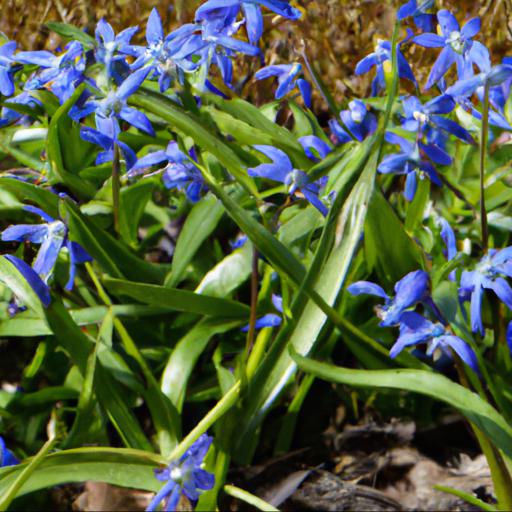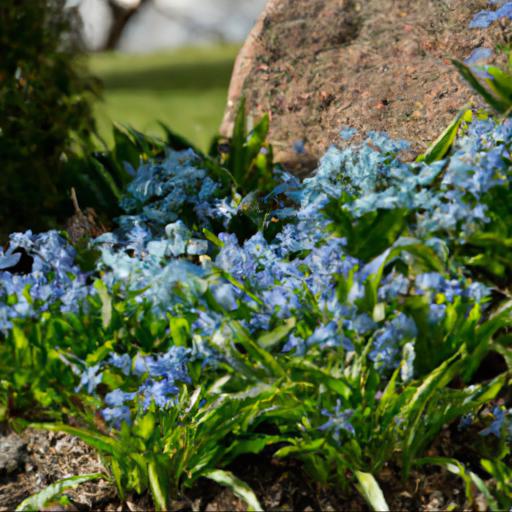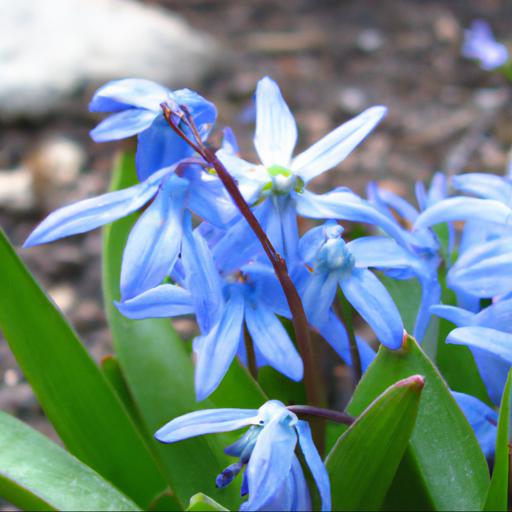Scilla siberica, also known as Siberian squill, is a beautiful spring-blooming flower native to the woodlands and meadows of northern Asia and Europe. It is a perennial bulbous plant with delicate blue, star-shaped flowers and has become a popular garden plant due to its low maintenance and easy care.
Scilla siberica is ideal for rock gardens, borders, and naturalized areas and makes an attractive addition to any garden. It is a hardy plant that blooms in late spring and is deer and rabbit resistant, making it an excellent choice for wildlife gardens. With its vibrant blue blooms and easy care, Scilla siberica is an ideal choice for any garden!
Growing scilla siberica: tips and tricks

Gardening in the UK can be a challenge, but growing Scilla siberica need not be. This vibrant bellflower is native to Asia and Europe and is happy in a range of climates and soil types. With a few tips and tricks, you’ll soon be planting and enjoying this popular bulb with ease.
When planting your bulbs, you should note that they need deep, well-draining soil with plenty of organic matter. Scilla siberica is partial to a sunny spot, and cooler developed countries like the UK are a great location for these bellflowers.
Aim for a mid to late-spring planting time for optimum results. Once your bulbs have taken off, it’s time to take some extra care to produce the best results.
Watering at regular intervals (about one to two weeks) is important, especially during extended periods of drought. Fertilizer can be applied two to four weeks after planting and again in the early spring. However, if you want to keep your bloom showier and longer, you can deadhead the flowers regularly.
With the right form of maintenance, your Scilla Siberica will be a beautiful addition to your garden for years to come. So why not give it a try and see what this vibrant bellflower can add to your garden!
Benefits of scilla siberica: health and beauty

. As a UK garden expert, it’s my pleasure to discuss the many benefits of the fascinating flower, Scilla siberica.
This bulbous perennial, commonly known as “Siberian Squill”, is widely cultivated for its usefulness in gardens, but is also a natural remedy for health and beauty. The most well known feature of this bloom is its lovely, springtime show of bright blue blooms. The fragrant bell-shaped flowers typically reach heights of 6-8 inches and look beautiful when planted in early spring.
This is an easy-to-grow plant, even for novice gardeners, and will bring an explosion of color to any flower bed. Not just limited to its beauty, Scilla Siberica is also a medicinal herb, long used in folk medicine to treat colds, headaches, and insomnia. Its root contains a mild sedative called glycoside which may be beneficial for treating symptoms associated with fatigue or stress.
Scilla Siberica also has antioxidant properties, which makes it an effective skin care ingredient. It can help to even skin tone, reduce scarring and dark spots, and even reduce puffy eyes.
Clearly, Scilla Siberica provides both aesthetic and medicinal benefits. As such, it’s an excellent choice for the UK gardener and is sure to bring a burst of spring-time color and a boost of health to your flower beds.
Scilla siberica in the garden: design ideas

Creating a beautiful garden with the perennial bulb Scilla siberica is an easy and fun way to bring beautiful blues and purples to any outdoor area. With its fragrant, bell-shaped blooms, this hardy spring bulb makes a great addition to rock gardens, spring borders, and natural woodlands. With a few design ideas, any gardener can incorporate Scilla siberica into their space to create a stunning garden.
The delicate beauty of Scilla siberica is best showcased when planted in groups, with their clusters of flowers sitting atop thin, spindly stems offering a bright burst of color in the sunshine. Planted in front of taller plants like irises or alliums, they will provide an captivating contrast of color and heights in spring borders.
For maxium effect, try planting large clusters of Scilla side by side, in long, even rows to create a dreamy’sea of blue’. For warm climates, Scilla can be planted in a trough or a raised bed, either as a statement piece alone, or as part of a wider spring plant palette. If planted in woodlands, it can help to create a carpet of color and soften the harshness of tall trees.
The key is to keep them away from afternoon sun however, as too much direct sunlight can cause discolouration of the blooms – around dappled shade or semi-shade is ideal. For colder regions,it may be best to steer clear of any areas prone to frost, so consider an area of the garden which will act as a sheltered spot and provide a snug environment for the bulbs.
Incorporating Scilla siberica into a garden is an easy way to add a pop of color, fragrance, and texture to any outdoor space. With careful consideration of planting positions and soil type, any gardener can enjoy the vibrant and fragrant blooms of this reliable spring bulb.
Scilla siberica care: how to keep your plant healthy
(USA)Scilla siberica care is a vital part of ensuring a healthy and beautiful garden. A member of the Liliaceae, or lily, family, Scilla siberica is a perennial bulbous plant that is native to Siberia and parts of Turkey.
It has many common names including Siberian squill, Siberian bluebell and wild hyacinth. One of the most beautiful features of Scilla siberica is its prolific star-shaped blue or mauve flowers. The foliage is a deep green, growing from a basal rosette of simple and ovate-shaped leaves.
Although it takes a few years to establish, a mature Scilla siberica plant will be around for many years. Caring for Scilla siberica is not a difficult task. When planting, select a sunny to partially shaded area with a soil that is rich in organic matter.
In areas where there is a risk of frost, it is best to plant Scilla siberica in the early spring. When choosing a location, consider that, although it prefers a moist soil, it can tolerate periods of drought.
Ensure that the soil is well-drained, as it does not like to be sitting in water. As Scilla siberica grows, deadheading spent flowers can help to encourage re-blooming.
Additionally, providing an extra bit of fertilizer in the spring will give your Scilla siberica a boost. Finally, once the foliage has died at the end of the season, leave it in place, as the plant will re-flower the following year. Scilla siberica is an easy plant to care for, and with the right location and attention, your garden will be a profusion of star-shaped blue or mauve blooms for many years to come.
Final Touch
Scilla siberica is a species of flowering bulbous perennial plant native to Siberia, Mongolia, and China. It is widely cultivated for its attractive blue flowers which bloom in early spring.
Scilla siberica is a low-maintenance plant that requires little care and can be grown in most soils. It is also tolerant of shade and cold temperatures, making it an ideal choice for gardens in cooler climates. Its flowers are an excellent source of nectar for early-season pollinators, and its foliage is deer-resistant.
Scilla siberica is a beautiful and hardy addition to any garden.
FAQ
What is the scientific name of Scilla siberica?
The scientific name of Scilla siberica is Scilla siberica.
Where is Scilla siberica natively found?
Scilla siberica is natively found in the temperate regions of Central and Eastern Europe, including parts of Russia, Ukraine, and the Caucasus.
What are the characteristics of Scilla siberica?
Scilla siberica is a bulbous perennial plant with blue, star-shaped flowers. It is native to the Caucasus region, but is now widely cultivated in gardens. It has narrow, strap-like leaves and grows to a height of 10-15 cm. The flowers are usually blue, but can also be white or pink. The flowers are borne in clusters of 6-15 and appear in early spring.
How does Scilla siberica reproduce?
Scilla siberica reproduces by seed. The seeds are spread by wind or animals, and the plant can also reproduce vegetatively by producing offsets.
What is the ideal growing environment for Scilla siberica?
The ideal growing environment for Scilla siberica is one that is moist, well-drained, and in partial shade. It should be planted in soil that is rich in organic matter and kept consistently moist.
What are the common uses of Scilla siberica?
Common uses of Scilla siberica include ornamental planting, medicinal purposes, and as a source of food for wildlife.

